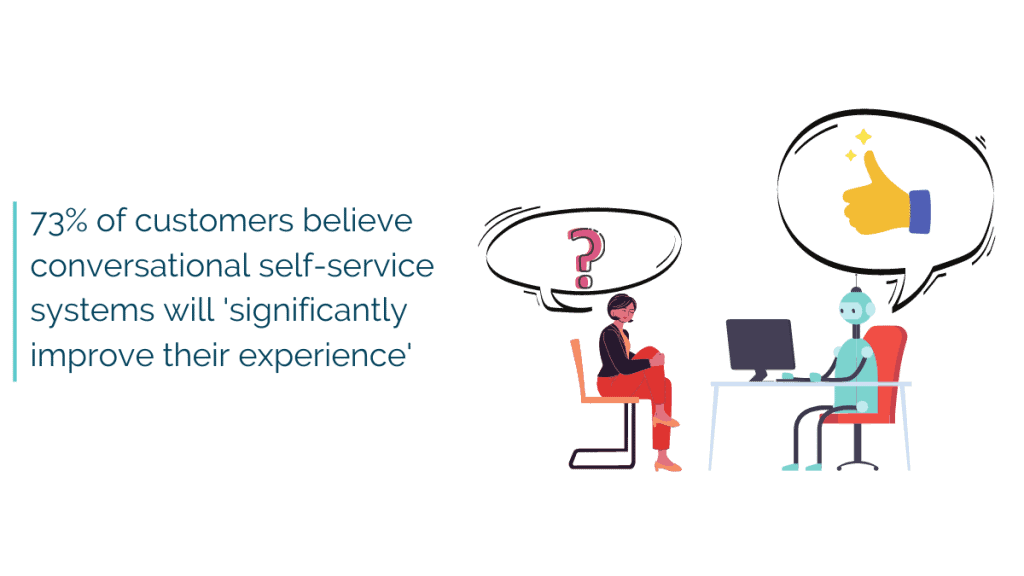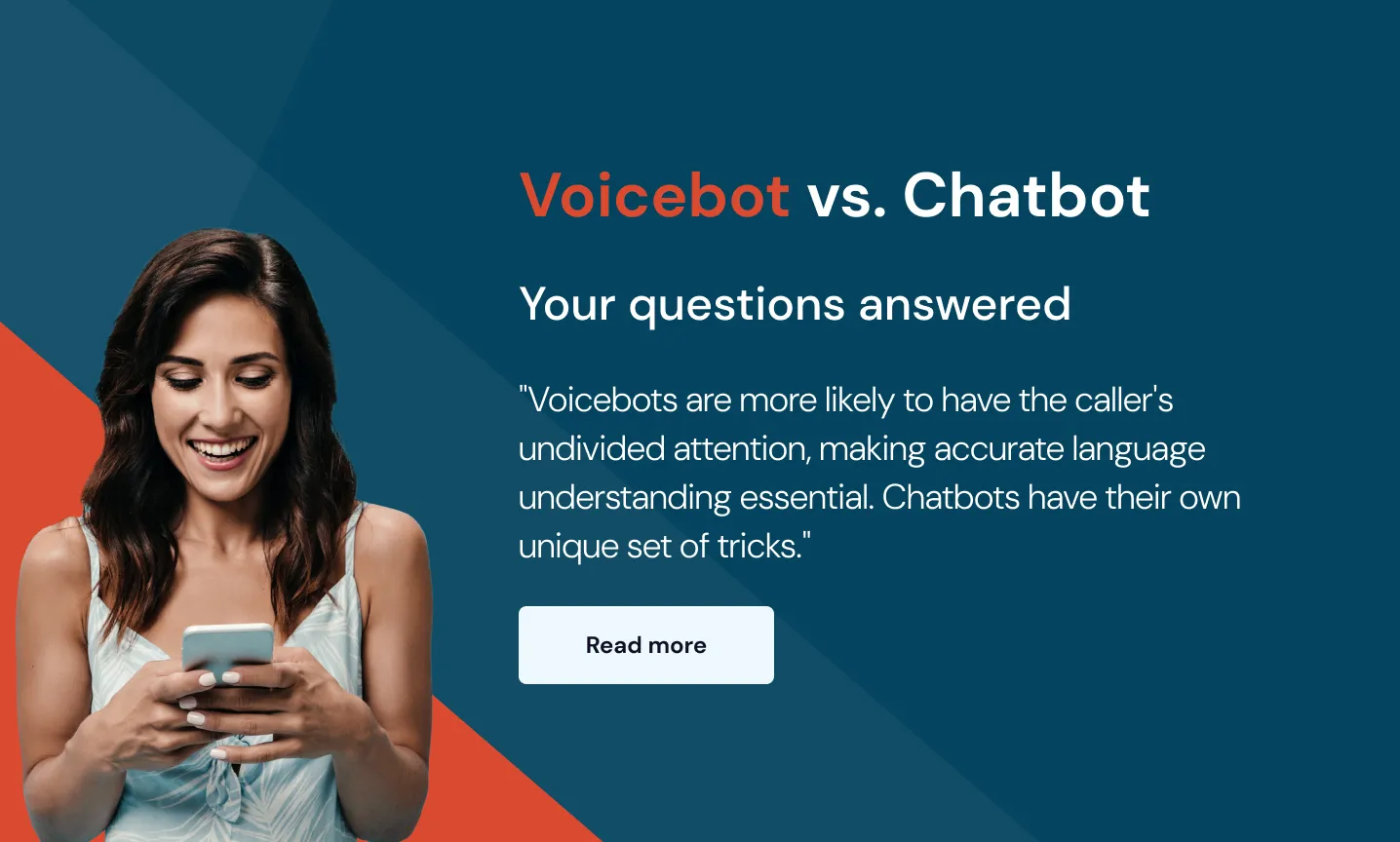Conversational AI is a buzzword in the customer service and contact center industry.
The tech promises to transform the way contact centers work. You’ll be able to serve more customers faster and at a lower cost.
Or so the story goes.
But how many contact centers are able to make full use of it?
Let’s find the answer to that question and more, starting with : just what is Conversational AI?
In this post:
- What is Conversational AI?
- Where is this tech used?
- How does Conversational AI work?
- What are the real-world applications?
What is Conversational AI?
Conversational AI is the technology that allows people to speak directly to computers.
Here’s the core idea: speaking to a live human agent is easy because there’s no mediating tech in the middle, no button pushing or typing.
Interacting with machines would be a lot easier if the same were possible.
That’s exactly what Conversational AI aims to offer. It ‘hears’ what you say, deciphers its meaning, and then formulates an appropriate response.
In other words, it acts like a person.
Does this exist in the real world?
Most people have some experience with Conversational AI through consumer voice assistants.
They’re pre-installed on every smartphone, and Amazon’s Alexa is another popular tool.
The vast reach of this technology means that, in the U.S., 128 million people a month used a voice assistant in 2020.
What about the contact center?
In the contact center, the primary use for Conversational AI is IVR technology.
IVR isn’t generally the best-loved piece of kit in customer services. That’s often because the IVR system is seen as a barrier to actual service.
In theory a great Conversational AI integration will change that dramatically.
A Conversational IVR gives customers the support they need, sometimes instead of an agent and sometimes in addition to an agent.
You can use it to enable self-service, route calls more effectively, or gather caller intent.
But, how does Conversational AI work?
The answer to this could be very long!
So let’s just cover the ‘must-know’ stuff.
Conversational AI uses several types of technology to work effectively.

Natural Language Processing
Natural Language Processing (NLP) takes your speech and transforms it into something machines can understand. Basically, it figures out which specific words you’re using.
Natural Language Understanding
Natural Language Understanding (NLU) technology focuses on understanding the context and the intent behind the words you’re saying.
Advanced NLU technology knows there are different ways to say the same thing.
It can understand accents, regional dialects, and the unusual and messy grammar structures we all use.
This is essential when rolling out Conversational AI tech in a contact center. Tools that can’t understand your entire customer base will frustrate customers.
Natural Language Generation
Natural Language Generation (NLG) is the technology that generates responses.
NLG can be as simple as adding data points into templated sentences. Scotland’s pollen index is an early example of the tech from way back in 2004.
The system took six data points every day – the pollen count in six regions of Scotland – and input this data into a template.
This allowed the organization to automatically generate a short summary of the country’s pollen count.
NLG can now go far beyond using narrow data points and templated sentences. Modern Conversational AI used in smart assistants can generate suitable responses to pretty much any topic.
Machine learning
Machine learning is driving the rapid advance of Conversational AI.
It lets the AI learn from interactions, helping it provide improved experiences each time.
The more data a Conversational AI system has access to, the faster it can learn. It’s why machine learning technology becomes more reliable as time goes on.
A clear example of this is in Gmail’s Smart Compose feature. It analyzes the auto-suggestions you choose and how you reply to emails to make its next set of suggestions even more accurate.
4 everyday examples of Conversational AI
The robots are among us!
By which I mean, Conversational AI use is more widespread than you might think.
This is great news for contact centers that want to implement similar systems; your customer base is already familiar with this type of tech.
Here are four types of Conversational AI that you have likely come across.
Virtual assistants
The majority of us can access Conversational AI via virtual assistants built into technology we use every day.
All smartphones have a digital assistant built-in: Siri on Apple phones and Google Assistant on Android.
These assistants are some of the more advanced examples of the tech that’s widely available.
And, being embedded in our phones, they can integrate with a wide variety of apps, vastly increasing their usefulness.
They help us make phone calls, send messages, set meetings, play music, search the internet, and more.
These virtual assistants are also spreading into other technology we use.
They now feature on everything from PCs and smart TVs to home appliances.
At last, we can have meaningful conversations with our refrigerators!

Google Smart Compose
You might have noticed a Gmail feature called Google Smart Compose.
This feature is designed to help you write emails faster by suggesting what you should write next.
If you like the advice, Google will automatically finish your sentence.
The tech reads your received emails to suggest a reply. It also analyses your writing in real-time to make suggestions.
Website support chatbots
If you’ve ever tried to get help online, you’ll likely have come across a support chatbot.
These are text-based platforms that answer simple support queries. They take steps to understand your question and then generate a suitable response.
The Avidia chatbot is a great example. The botanical hair and skincare brand used its chatbot to process online bookings automatically.
It processed 6,918 books in its first seven weeks, resulting in a 7.67% increase in overall bookings – all without any agent input.
Conversational IVR
Conversational IVR understands what callers say and generates responses based on this information.
It’s good for data input, solving simple self-service help queries, and routing callers to the most appropriate agent.
Contact centers can see huge benefits by implementing one of these systems.
For example, US Airways reduced AHT by 10% and increased call containment by 5% after introducing a Conversational system.
Conversational AI is most useful when integrated with other tools
Conversational AI really becomes useful when it is integrated with other programs. This allows the voice input to control other programs.
Think about smartphone assistants.
It’s one thing for an AI to understand the meaning of the phrase “Play the Beatles.” But it’s only useful if it can access a music provider to actually do so.
The same is true in contact centers.
Suppose you replace your regular IVR with a Conversational one. The tech needs to integrate with your booking system, CRM, or call routing technology to act on the input it receives.






